How to Identify Koa?
Sep 13, 2020
Being one of a small number of businesses that work with and specialize in Koa, I’ve often become a go-to resource when people are trying to identify Hawaiian Koa. I’ve received pictures of everything, from bowls to frames and pepper mills to wood boards, from customers asking the question “Is this Koa?” This article is for them and anyone else who is curious about how to identify Koa wood.
You can identify Koa by examining three primary attributes; color, grain, and origin. Koa is generally reddish gold to dark brown in color. Its acute interlocking wood grain produces a highly curly or figured appearance. Its origin is always Hawaii.
However, Koa wood’s appearance can be highly variable. Different elements must be taken into consideration when evaluating whether or not the wood in question is Koa. Its variability is one of many attributes that make Koa interesting and special, but also why identifying it can be difficult and close to impossible unless you have the benefit of working with Koa for a long time.
That said, in my experience growing, milling, and working with Koa wood, below are some factors to consider when trying to identify Koa.
Where Did the Wood Come From?

Koa is endemic to Hawaii. It does not grow anywhere else in the world. And although there are terms like “Brazilian Koa” and “Australian Koa,” neither of them is Acacia Koa. (Acacia is a large genus of shrubs and trees in the subfamily Mimosoidease of the pea family Fabaceae. Koa is a member of this plant family.)
Koa has very specific growing requirements and conditions that include temperature, elevation, soil, and rainfall. Only particular areas in Hawaii can provide the necessary conditions for Koa to grow. Therefore, any wood or wood object that doesn’t have its roots (no pun intended) in Hawaii, is NOT Koa.
What Color is the Wood?
Koa is primarily reddish gold and dark brown, but within that color range, there are many different shades and hints of yellow and blonde. Color, like many other characteristics of Koa, is often determined by genetics, age, and where the tree grows.
Wood from younger trees is less dense and typically lighter in color than wood coming from old-growth Koa. Being young, most of the tree is made up of sapwood, the active tissue of the tree. (Sapwood is the outer light-colored portion of a tree trunk through which the water passes from the roots to the leaves. It is the lighter part of the tree trunk. In the picture below the wood blank on the left is the younger tree. When compared to the blank on the right, harvested from an older tree, you can the difference in the amount of sapwood.) Wood harvested from younger trees (less than 30 years old) have not yet developed a large mass of heartwood. This can potentially make it harder to identify it as Koa.

Older trees, which have had the opportunity to develop greater heartwood, are denser and typically have a darker and clearer color range. These are more likely to have prominent characteristics associated with Hawaiian Koa which make it easier to identify.
Koa grows on multiple Hawaiian islands but the Big Island tends to produce the darker and more desirable wood color. This is believed to be the result of the Big Island’s soil. Being the newest volcanic island, the Big Island's soil is younger and more acidic. This soil attribute is thought to affect some characteristics of the wood, including color.
Another influential factor in Koa color and grain determination may be in its genetics. Studies have found distinct differences in the genetics of trees growing on different islands. These differences may be associated with differences in wood attributes and characteristics.
The following images exemplify the large range of Koa wood colors.
| Varying Colors of Koa Wood | ||
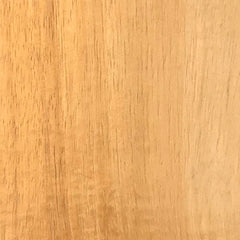 |
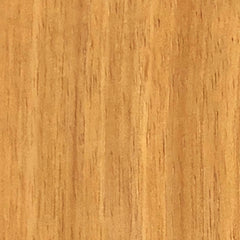 |
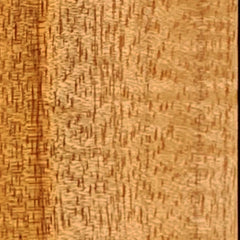 |
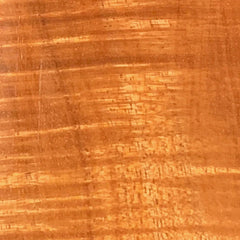 |
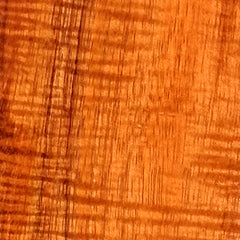 |
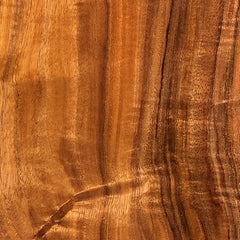 |
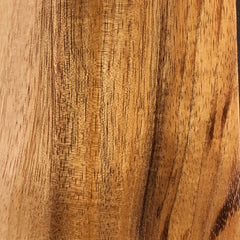 |
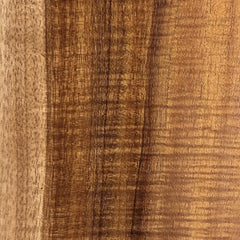 |
 |
What Does Koa Wood Grain Look Like?
You may hear different types of phrases used to describe Koa patterns (e.g. fiddle back, tiger stripes, bird’s eye, curly, super curly etc.), however, it’s important to note that there are no standardized categories to describe Koa wood grain. With that said, I’ll share the three most common types of Koa grain that I encounter and label as straight, curly, and figured.
Straight - describes wood grain that runs in one direction. It has little waving or curl, the grains are mostly parallel.

Curly - describes a wood grain that has been compressed and produces alternate stripes perpendicular to the face of the wood. This compression creates the visual illusion of a three-dimension surface, also known as chatoyancy. This is Koa’s most desirable characteristic and what Koa is known for producing.

Figured - is similar to curly in the sense that compression and other factors cause a desirable looking effect. Unlike curly, however, it is not necessarily perpendicular to the surface. It may contain uneven twists and unpredictable turns in the grain.

Within the same tree, the wood figuring and grain can vary greatly. From high curl and chatoyancy to straight grain and figured. Some say, the more desirable curly or figured grain is only about 10% of the Koa tree. I don't necessarily agree. I often find, especially with our old-growth Koa trees, that it can be as much as 30-40% (and in some cases more).
These more desired attributes are what define and identify Koa as Koa. These qualities are more predominant in trees that have lived out their life cycle. Generally speaking, because a tree that has lived out its cycle has been exposed to a lifetime of stress. Over the years, stressors like branch weight, wind, and storms force the tree to grow in a way that the tree can best acclimate to its environment. This promotes particular grain growth that can result in desired grain patterns.
Another factor that can affect grain appearance is elevation. The higher the elevation, the cooler the temperature. The cooler it is, the slower the tree grows. The slower the tree grows the higher the quality and more apparent are the stressors in the grain pattern.
Lastly, the way the wood has been milled (e.g. quarter sawn) can also affect how prominent those desired characteristics appear.
Is Koa wood heavy?
Koa is a hardwood and considered a moderately heavy wood. According to the US Department of Agriculture, Forest Product Laboratory, Koa’s technical weight is .63 specific gravity. (Specific gravity is a measure of the ratio of a wood’s density as compared to water. If the wood were the same density as water, the specific gravity would be 1.00.) It is slightly heavier than Walnut (.55 specific gravity) and lighter than Ironwood (ranges .70 - .99 specific gravity). Having said that, however, like many other facets of Koa, it can vary.
What Does Koa smell like?
Koa has a sweet and woodsy fragrance. This is noticeable each and every time I open and close the dehumidifier (used in the wood drying process.) However, unless you’re working with Koa under these conditions or in the presence of huge about of shavings, for example as a result of woodturning or milling, Koa doesn’t really have a smell that is easily detectable.
How to Be Sure it's Koa?
So you've confirmed the wood IS from Hawaii. Its color matches a shade of color within the color range of Koa. AND it shows signs of curl and/or figuring consistent with Koa. It must be Koa?
In all likelihood, it may be Koa. Unfortunately, Koa's attributes, although pronounced in Koa, are not necessarily exclusive to Koa. For example, Maple can have similar curls and figuring and Walnut may share in some of the color shades. This makes it difficult to conclusively identify a wood piece as Koa. And although I can identify a probability of whether or not something is Koa from looking at a picture, it's difficult to know with absolute certainty unless I have it in my hands...and even then, it comes with no guarantees.



